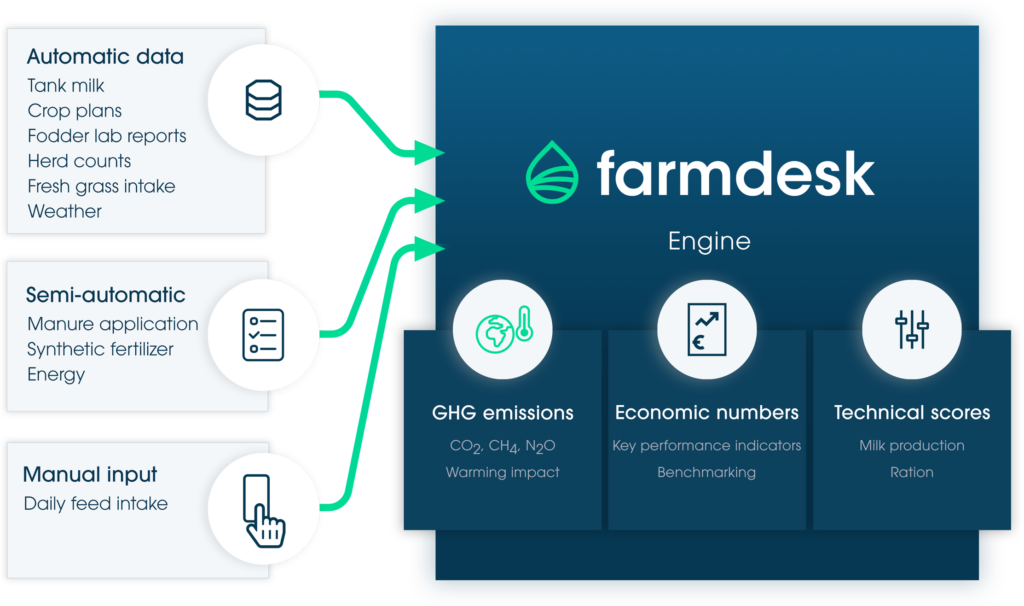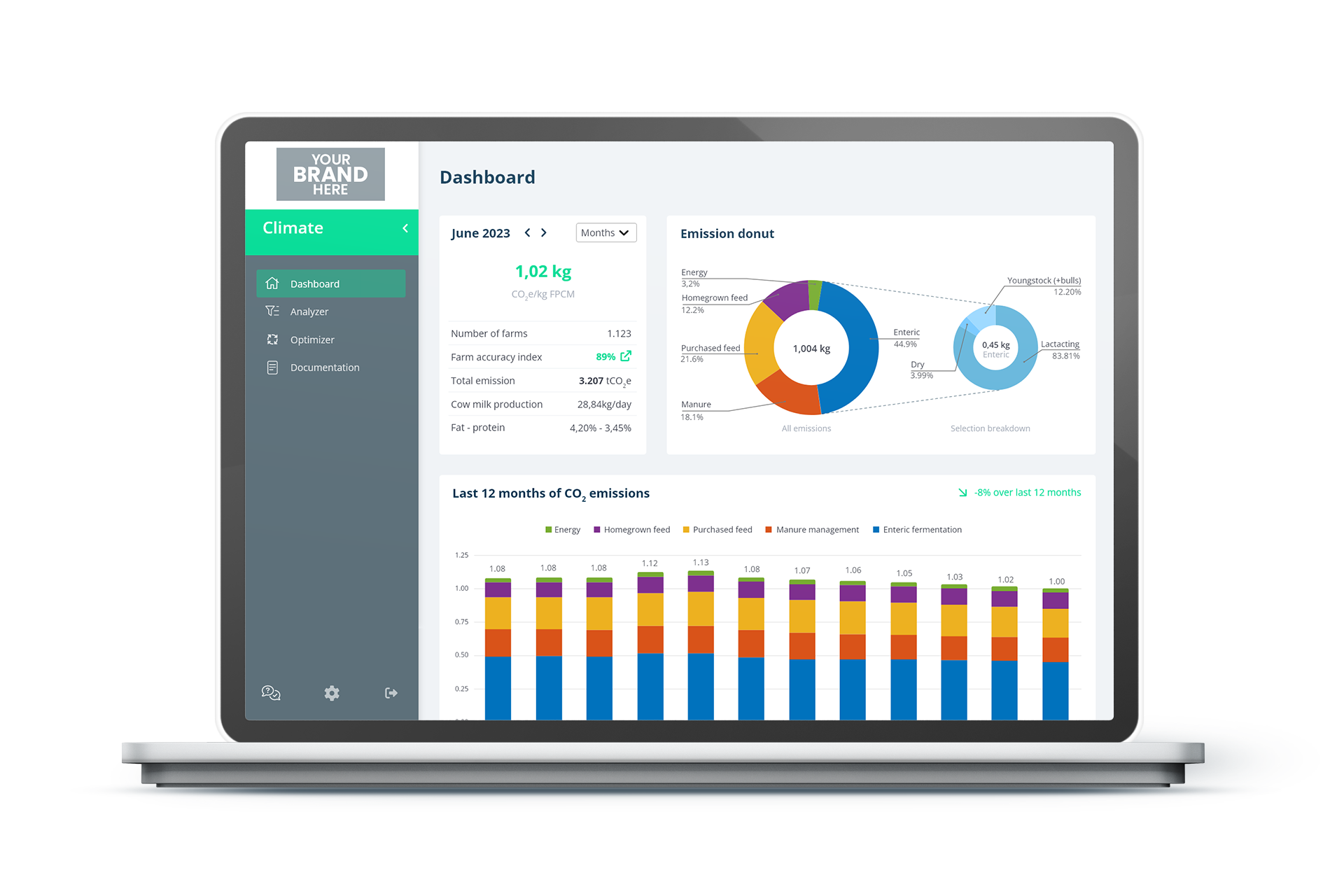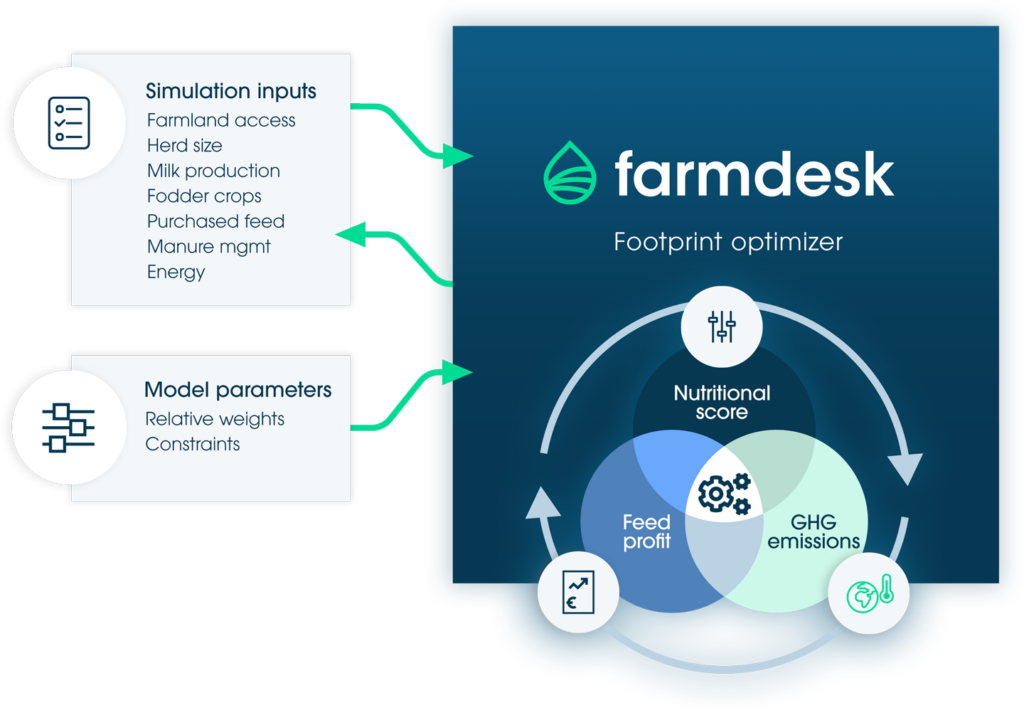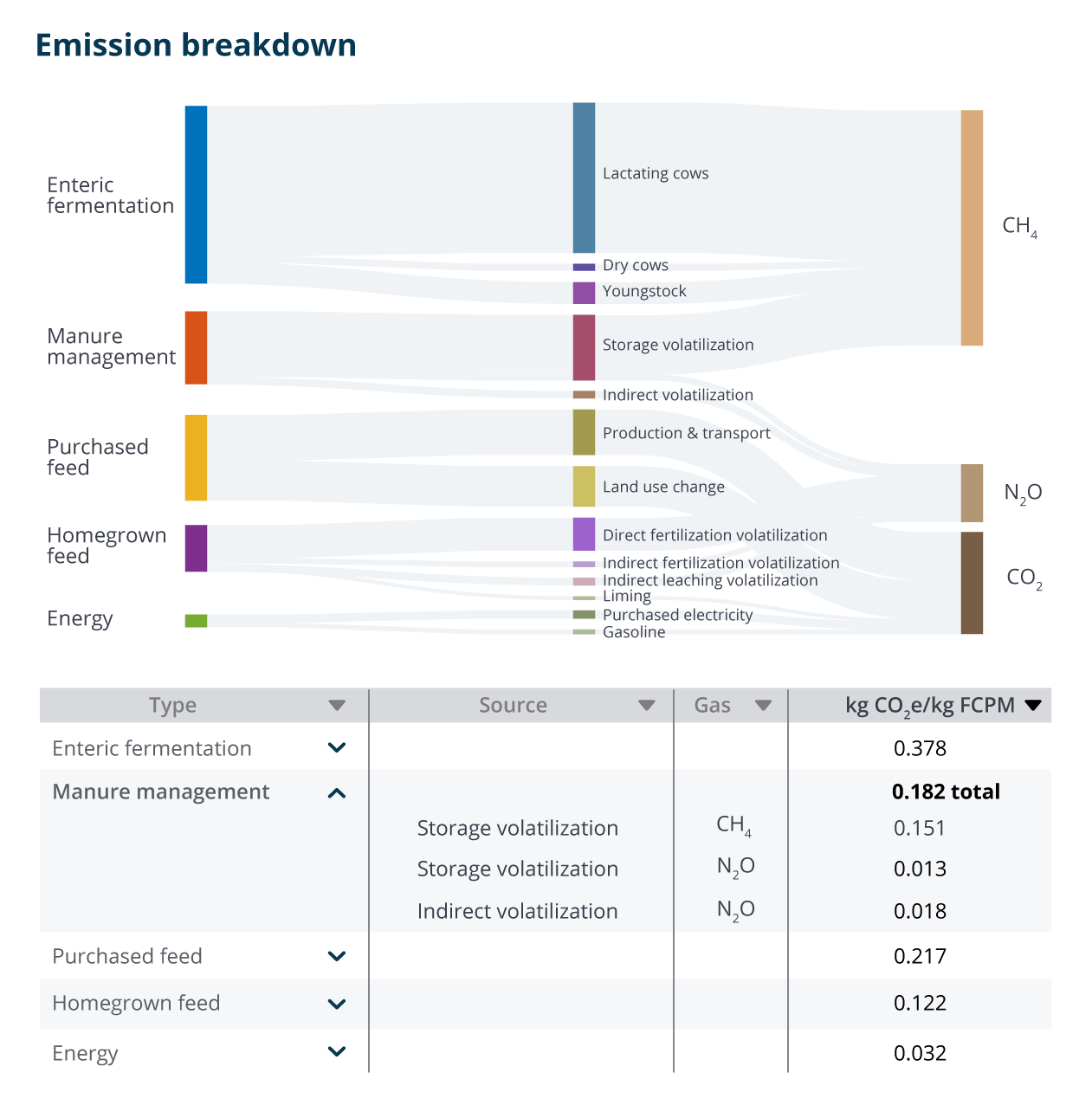Reduce emissions.
Achieve goals.
Reducing the carbon footprint on dairy farms by positively incentivizing dairy farmers. Unique to dairy companies and other stakeholders.
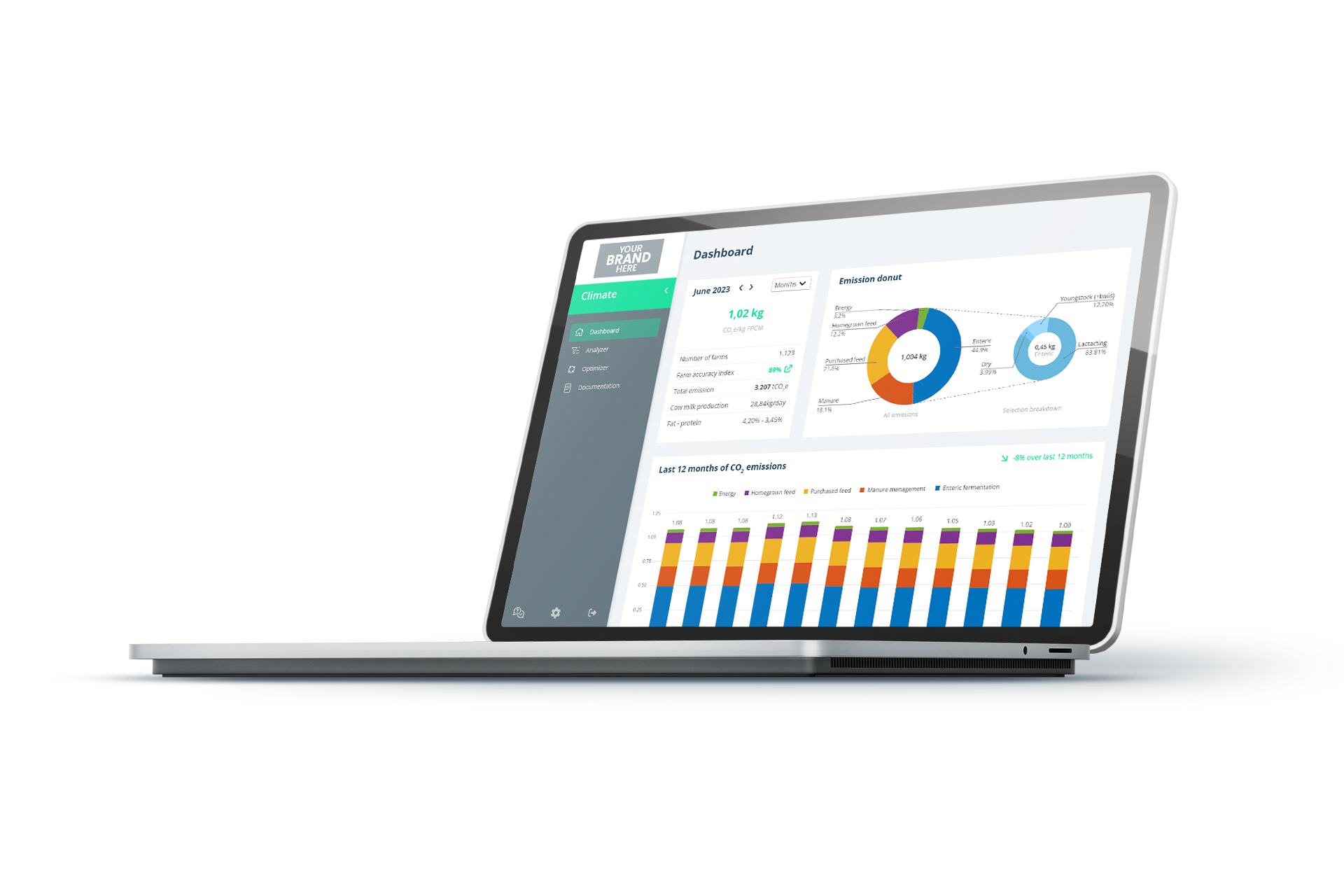
Why choose Farmdesk Climate?
Added value
No additional burden for dairy farmers, but more insight into technical-economic KPIs and access to useful tools.
Up-to-date
Reduction
Not only reporting but also reducing emissions through the Footprint Optimizer that takes techno-economic feasibility into account.
Custom-made
Customized to your company's needs. Market the product under your own logo and substantiate your story.
In practice

For dairy farmers: daily joy
We understand dairy farmers. We know they are not looking for additional administrative burdens.
Through the handy smartphone app, the dairy farmer provides the necessary inputs; in return, he gets added value: smarter feeding, visibility into technical and economic KPIs, comparison with other dairy farmers ... and more.

For sustainability officers: the full picture
The corporate interface provides an overview of all participating dairy farms. Greenhouse gas emissions as well as other performance indicators are calculated and updated on a daily basis.
Useful for creating analyses and exporting to reports throughout the year.
Backed by science
Science-compliant
Our calculations and methodology reflect the IPCC's carbon footprint science.
Standards-aligned
We adhere to the international standards in carbon footprinting for the dairy sector from IDF.
Independently certified
We are certified by Vinçotte, confirming our compliance with the ISO 14067:2018 standard for quantifying and reporting carbon footprints.
Short interview about Farmdesk Climate
Watch an interview with our CEO, Jef Aernouts, at the World Dairy Summit of the International Dairy Federation in Paris
"We need the farmers along the way and for that you need to understand the farmers. This farmer-centered approach is the key to real change in the dairy industry."
Jef discussed the relevance of Farmdesk Climate tool, an innovative solution that helps dairy farmers monitor and reduce their CO2 footprint. The tool uses a scientifically validated methodology to calculate greenhouse gas emissions and identify opportunities for improvement.
"Let's work together for a more sustainable future for dairy farming!"
A sustainable future for dairy farms and the planet
Climate Change
Climate change is one of the greatest challenges facing the world. It is caused by warming due to the increasing concentration of greenhouse gases such as carbon dioxide (CO2), methane (CH4) and nitrous oxide (N2O) in the atmosphere.
In 2024, at the UN Climate Change Conference in Dubai (COP28), the goal of the Paris Agreement (COP21, 2015) to limit the increase in global average temperature to below 2°C above pre-industrial levels reaffirmed. Globally, 2023 was the warmest year on record, and average global temperatures during the 12-month period between February 2023 and January 2024 were 1.5°C above (1) the pre-industrial level. Europe is the fastest warming continent in the world.
The European Union has two main climate deadlines: 2030 and 2050. By 2030, it wants to emit 55 percent less greenhouse gases than in 1990. And by 2050, the EU wants to be completely climate neutral.
Agricultural emissions
Like every other part of our global economy, agriculture contributes to climate change. The dairy sector plays a prominent role and is particularly known for its methane emissions from enteric fermentation.
Less discussed but also important are methane emissions from volatilization in manure, nitrous oxide emissions from fertilization and carbon dioxide emissions from fuel use and land use changes.
The dairy sector has strong levers to address climate change in the short term.
Reducing emissions
The net emissions of the long-lived greenhouse gases carbon dioxide and nitrous oxide must go to zero. These gases accumulate in the atmosphere and stay there for hundreds of years, causing long-term warming.
Methane is a short-lived but powerful greenhouse gas: it breaks down in the atmosphere so that only about half of it remains after ten years. Its short lifespan and biogenic nature makes it a powerful tool in the fight against climate change. If we reduce methane emissions fast enough,the amount of methane in the atmosphere will rapidly decrease, which on short term to cooling can lead (2). On the other hand, an increase in methane emissions would cause significant warming.
The facts
Milk is the basis
70 to 90% of the footprint of any dairy product comes from the raw milk production on the dairy farm.
Feed is the lever
About 75% of the carbon footprint of raw milk is related to feed and crop management.
Feed cost is key
Feed management determines more than 50% of total operating costs. "Econological" realism is the key to success.
The possibilities
Monitor emissions
Emissions of CO2, CH4 and N2O are calculated in accordance with the international standards.
Determine impact
Milk production, feed cost and other performance indicators are determined to monitor the viability of the farm.
Optimize
Through smart algorithms, arrive at a minimal footprint at maximum technical and economic performance.
Farmdesk Climate
The full picture
Farmdesk Climate does not focus unilaterally on only greenhouse gas emissions, but also includes the economic and technical impact on the dairy farm, relying on the machinery of Farmdesk Dairy.
Data is collected automatically as much as possible, improving both accuracy and ease of use.
Understanding emissions
Greenhouse gas emissions are broken down by source and expressed in kg CO2 equivalents per kg of standard milk. Emissions are calculated in accordance with international standards: IDF global carbon footprint for the dairy sector; (IPCC 2019 Refinement to the) 2006 IPCC guidelines for National Greenhouse Gas Inventories; 2013 Supplement to the 2006 IPCC Guidelines for National Greenhouse Gas Inventories: Wetlands; PEFCR Dairy guideline.
Reduce emissions
The Footprint Optimizer suggests farm-specific opportunities to adjust inputs (cropping plan, fertilization, rations, manure management...) and improve outputs (greenhouse gas emissions and feed profit).
Want to learn more about the power of Farmdesk Climate?
Farmdesk Climate helps to reduce CO2-footprint of dairy farms while ensuring viability.
